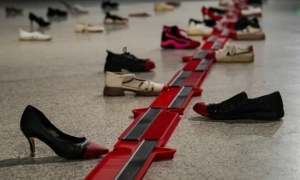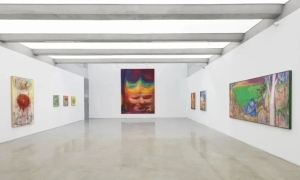可以说“小说月报”是一批十分强调地域性色彩的绘画,所充塞的形象是属于我们自己的。从视觉上来讲,这些绘画可能会给人一种似食物半生不熟,难以下咽的生涩印象——生硬的色彩,呆板的人物姿态,以及在风格方面看似对早期土油画的有意无意地摹仿。我将自己这些绘画所暴露出的意图,看作是在做一次清醒的撤退——一方面是退回自己身体内部,可以解释为内向性与记忆化的,带有吸允性质的,甚至是自我嘲讽的;另一方面则是意味着漠视时尚,像收捡旧货一般捡回一些值得玩味的绘画样式和手段,从新拆装以期从过时的绘画语汇中吸取热量。这是一种刻意的保守姿态。当有人面对这些绘画时说:“你画的这些人物是你自己么?”或说“你的画给人一种既陌生又非常熟悉的感觉。”老实说这类看法令我觉得满意。但这不够。我画画是认为绘画在今天仍具有触人心脾的能量,能够带给我们许多已经匮乏的记忆力。绘画可以使我摆脱贫困的吞噬以及给苍白的时光涂抹上一些颜色的愿望变为可能。绘画可以给我带来孤立的快感。
另外,我喜欢绘画在当今倍受冷落的境遇,只是在这样一个角度:绘画的“过时感”在我看来,它恰恰可能成为绘画在今天存在的意义,它以这样的方式发人深省,激动人心,我是说绘画被抛入到充满活力的自言自语式的吟咏独白的角色之中。我以为这是今天绘画存在的真相,我在力图使自己的工作能够证明这一看法。
——这些作品模拟了一些并非存在的“场面”,是一些虚构,更是一种气息。我反复使用了一些单调的色彩与近乎重复的形象,我的企图就是质地化某种我仿佛可以触摸得到的气息。形象与色彩在这里象构成音色的音粒,使我试图把握的,若隐若现隐匿于其中,尽管画面中的人物们是刻意打扮的结果(顺便说,我并不清楚他们是如何身份,是谁?再说这并不重要)。其实“打扮”并没有什么具体的含义,只不过是为了满足我刻画某类质地的欢娱感而已。我让人物们穿上硬梆梆的工裤,套上靴子戴上帽子——就类似我喜欢用颜色描述沙土泥地一样,在我的画面中,土丘与荒地总是有机会被描述出来。说穿了在我的绘画中, 形象是缺少动机的,或是说不象现实主义绘画所依赖的那类视觉规则——形象负载着明确的动机与目的驶向远方的不毛之地......
“属于我们的”种种场面故事,天空土地和文字,是些混乱驳杂的信息的情节和图象拼凑,与其说似有所指不如说含糊其辞倒更为精当些。我喜欢暗示的动机胜过暗示。我喜欢丧失掉目的性的形象。我也喜欢搬用形象。喜欢描绘不可能描绘的东西,比如气味和声音。还有我讨厌非此即彼。
图象的暧昧性是绘画的本能和权利。我一向认为画家应该有意识的“享乐”这一“规则”。大多数现实主义绘画是带有很强烈的“禁欲”色彩的绘画,因而图象所包含的信息也是具有明确动机和目的,因而从本质上来说也是贫困的。再这个意义上,“小说月报”所流露出的绘画意识,与现实主义的绘画原则相对立。
……有一瞬间,我仿佛觉得自己的脑袋是一栋堆满了杂物的库房,画画就像是推开了这间仓库的大门,当我在平面上试图呈现那些杂乱的物什的时候,发现它们就在这时候消失得无影无踪,除了那些物什所散发出令人晕眩、使人沉迷的气息外,眼前只是一片空旷。因此,当我开始工作,所面对的只能是这种看不见得存在。
从某种意义上来讲,我的绘画就是一次次努力逼进这种气息的结果;是接近它确定它的唯一途径和手段。这种气息对于我几确切又莫名,比我们赖以存在的这个世界要真实的多,可信的多。
The "Short Story Magazine" By Wang Yin The paintings in the Short Story Magazine series, composed of images that "belong to us", can give the impression that I concentrated on "regional" schemes of tone. Visually, these paintings make us think of undercooked food difficult to swallow. They seem rough: the colors are harsh, the postures stereotyped, and the style suggests a semiconscious reference to early Chinese oil paintings. I think they express my original intention to make a sober retreat - in one sense returning to inside my own body, which could be interpreted as a tendency towards introspection and calling up of memory, a tendency colored by the desire to draw from the past, even a kind of self-mockery. In another sense, my approach represents a certain aversion to what is fashionable: just as other people collect used objects, I recuperate techniques and ways of painting that seem to me worthy of consideration. This attitude is deliberately conservational. When someone looking at my work said, "Aren”t you painting yourself through these subjects?" and "Your paintings convey a feeling that”s both strange and very familiar at the same time", to tell the truth, I was pleased. But that was not enough. If I paint, it”s because I believe that painting today can still have the power to touch our hearts and revive long since wilted memories. Painting offers a possibility to my aspirations, the hope of breaking away from poverty, the hope of heightening the colors of pale days. When I paint, I take pleasure in being alone. But, even though I like to paint in today”s condition of ever increasing solitude, it is because the impression given by a painting of "obsoleteness" might be exactly what gives meaning to the fact that paintings still exist today. It is their way of raising questions and stimulating thinking. By that, I mean that painting has been relegated to the function of those great actors whose only remaining form of expression was the soliloquy. I am convinced that this is our present condition and I try to demonstrate this point with my work. These works simulate scenes that have never existed in reality; they are completely fictional, an atmosphere more than anything else. I used monotonous colors in a repetitive way and images that are almost "cut-and-paste". My intention was to give form to certain currents of energy that are sometimes palpable to me. Images and colors only serve here to create a timbre, to make appear, in a stealthy or evident manner, what I intended to capture. This is in spite of the fact that the subjects are deliberately "dressed" (incidentally, I have absolutely no idea who they are, or any idea about their identity and that, furthermore, I don”t care). It is useless to look for a concrete meaning in the way they are "dressed" - in so doing I was only trying to satisfy my desire to represent certain textures. I made them put on the austere clothing and boots of workers and I made them wear caps in the same way I like to paint sand, earth, and dust - in my paintings you are almost always certain to come across a dusty hill or fallow ground. It can be said that the images that appear in my paintings have no raison d”etre or that they have no relation to the vehicle of visual impressions which constitute the basis of realistic painting, images that carry a blatantly obvious meaning or intention and whose direct consequence is sterility. The writings, landscapes, and stories that "belong to us" are collages of scenes and images, expressing a confusion of information that can probably be more accurately described as obscure than evocative. I prefer the spirit of evocation to direct evocation. I like pictures without precise intentions. I like to transpose images. I like to paint what cannot be painted, such as a flavor or a sound. And I hate having to be either this or that. Ambiguity is an instinct and a prerogative of painting. I have always thought that painters should consciously "take advantage" of this premise. Most realistic paintings have a very "ascetic" quality making the intention and subject of their images so clearly defined that the paintings are deprived of vitality. In this respect, the graphic style used in the paintings of the Short Story Magazine is diametrically opposed to the principles of this kind of realistic painting. There are moments when my brain feels like a warehouse filled with miscellaneous bric-a-brac. Painting should be a way to open the doors of this warehouse, but when I try to represent these objects on canvas, I see they have disappeared without a trace. Apart from the vertiginous and addictive feeling they impart, all that remains before me is emptiness. That is why, when I start working, what confronts me is invisible. In a sense, my painting is the result of repeated attempts to capture this impression. The only manner and the only way to approach it. Because this atmosphere, which is both vague and precise, is far more real and believable than the world on which we depend. 1997





















